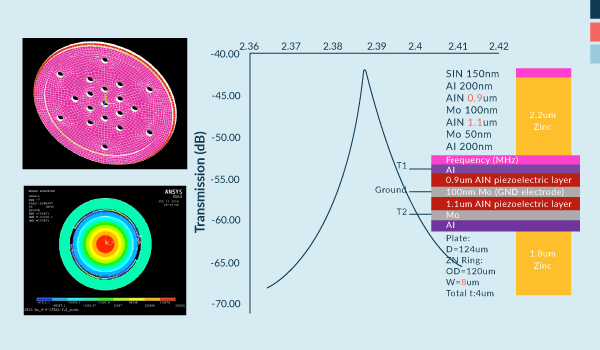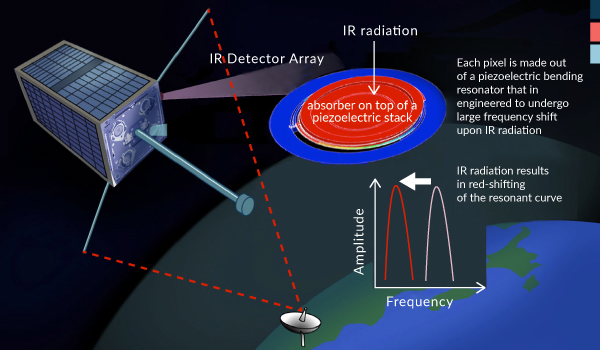Above:
Resonant Detector Array. Scanning Electron Microscope (SEM) image of a resonant piezoelectric infrared detector array with a very wide dynamic range of operation (wide temperature range of operation).The array measures approximately 880µm x 580µm.
HOTIR
IR Detectors at Any Temperature
Mina Rais-Zadeh – Valerie Scott – Cliff Frez – X. Bao – S. Sherrit
There is a wealth of information in the long wavelength infrared (IR) region from 15 µm to 100 µm. However, the detector technologies that can measure the IR energy with low noise in this range are limited in capability and precision. High Operation Temperature Infrared (HOTIR) detectors are currently being developed to address the need for uncooled resonant IR detectors, The frequency of the detectors shifts proportionally to the amount of absorbed IR power. These sensors are capable of operation in a wide range of frequencies and in extreme temperature environments. HOTIR detectors are sensitive to a broad range of spectra from ultraviolet to far-IR with ultra-low-noise performance and frequency multiplexing capability.
These detectors are higher performance alternatives to microbolometers and offer lower cost, lower power and smaller-size alternatives to kinetic inductance detectors with similar frequency multiplexing capabilities, all without the need to be operated at a specific and narrow temperature range defined by the superconducting transition temperature. Each pixel of the detector array is composed of an acoustic resonator with high-quality factor (Q) and high-Temperature Coefficient of Frequency (TCF). The resonator geometry is engineered such that the material properties of the material set in the resonating stack does not limit their TCF. Instead, the resonator exhibits TCF in the order of 1,000 parts per million per degree Celsius, which is 30-fold larger than the TCF if defined by the temperature coefficient of elasticity. These detectors need not be cooled to be functional, but their background noise will be significantly suppressed at low temperatures and their Qs will become even higher. This means that, depending on the application; they can be cooled to any temperature to meet the science need. In addition, nanofabrication allows integration of thousands of pixels to form a large imaging array.
This project is directly related to the JPL strategic goal of expanding its science instrument capability for small satellites and CubeSats by providing an uncooled, lower size, weight, and power (SWAP) thermal imager alternative to cooled imagers and higher precision alternative to thermopiles and bolometers).
HOTIR Model and response of a stress engineered resonant IR detectors with TCF of > 1000ppm/K providing high sensitivity, uncooled IR imaging capability.
+ Larger image




